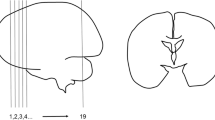Summary
Ependymal cells in the ventricular wall and in several circumventricular organs of the rat were compared by means of freeze-fracturing. In principle, tight junctions and orthogonal arrays of particles (OAP) do not coexist in the cells bordering the ventricular wall: (1) Ordinary ependymal cells of the rat possess OAP and are devoid of tight junctions. (2) Epithelial cells of the rat choroid plexus are connected by tight junctions; OAP are lacking here. In some cases, however, tight junctions and OAP coexist in the same cell. In the boundary zone between choroid plexus and ependyma of the rat, the density of OAP is very low, whereas the tight junctions are well developed. In the subfornical and the subcommissural organ (SCO) of the rat both structures are poorly developed; in the SCO they occur segregated in different membranous areas. An overview of the literature confirms that tight junctions and OAP mostly exclude each other. The possibility that in astrocytes and ependymal cells tight junctions may have been replaced by OAP during phylogeny is briefly discussed.
Similar content being viewed by others
References
Anders JJ, Brightman MW (1979) Assemblies of particles in the cell membranes of developing, mature and reactive astrocytes. J Neurocytol 8:777–795
Brightman MW, Reese TS (1969) Junctions between intimately apposed cell membranes in the vertebrate brain. J Cell Biol 40:648–677
Bruni JE, Del Bigio MR, Clattenburg RE (1985) Epcndyma: Normal and pathological. A review of the literature. Brain Res Rev 9:1–19
Claude P, Goodenough AD (1973) Fracture faces of zonulae occludentes from “tight” and “leaky” epithelia. J Cell Biol 58:390–400
Cullen MJ, Gulley RL (1980) Freeze-fracture studies of the macromolecular organization of glial membranes. Trends Neurosci 3:113–116
Dermietzel R, Meiler K, Tetzlaff W, Waelsch M (1977) In vivo and in vitro formation of the junctional complex in choroid epithelium. A freeze-etching study. Cell Tissue Res 181:427–441
Deurs van B, Koehler JK (1979) Tight junctions in the choroid plexus epithelium. A freeze-fracture study including complementary replicas. J Cell Biol 80:662–673
Gotow T (1984) Cytochemical characteristics of astrocytic plasma membranes specialized with numerous orthogonal arrays. J Neurocytol 13:431–448
Gotow T, Hashimoto PH (1979) Fine structure of ependyma and intercellular junctions in the area postrema of the rat. Cell Tissue Res 201:207–225
Gotow T, Hashimoto PH (1982a) Intercellular junctions between specialized ependymal cells in the subcommissural organ of the rat. J Neurocytol 11:363–379
Gotow T, Hashimoto PH (1982b) Fine structural studies on ependymal paracellular and capillary transcellular permeability in the subcommissural organ of the guinea pig. J Neurocytol 11:447–462
Gotow T, Hashimoto PH (1984) Plasma membrane organization of astrocytes in elasmobranchs with special reference to the brain barrier system. J Neurocytol 13:727–742
Hatton JD, Ellisman MH (1981) The distribution of orthogonal arrays and their relationship to intercellular junctions in neuroglia of the freeze-fractured hypothalamo-neurohypophyseal system. Cell Tissue Res 215:309–324
Hatton JD, Ellisman MH (1982) The distribution of orthogonal arrays in the freeze-fractured rat median eminence. J Neurocytol 11:335–349
Kästner R (1987) Comparative studies on the astrocytic reaction in the lesioned central nervous system of different vertebrates. J Hirnforsch (in press)
Leonhardt H (1980) Ependym und circumventrikuläre Organe. In: Oksche A, Vollrath L (ed) Handbuch der mikroskopischen Anatomie des Menschen. Neuroglia I. Springer-Verlag, Berlin, Heidelberg, New York, pp 177–666
Mack A (1986) Heterogenität der Astroglia und des Ependyms des Gehirns der Ratte im Gefrierbruch. Diplomarbeit der Fakultät für Biologie der Universität Tübingen
Mack A, Wolburg H (1986) Heterogeneity of glial membranes in the rat olfactory system as revealed by freeze-fracturing. Neurosci Lett 65:17–22
McNutt NS, Weinstein RS (1973) Membrane ultrastructure at mammalian intercellular junctions. Prog Biophys Mol Biol 26:45–102
Meller K (1985) Ultrastructural aspects of the choroid plexus epithelium as revealed by the rapid-freezing and deep-etching techniques. Cell Tissue Res 239:189–201
Nakai Y, Ochiai H, Uchida M (1977) Fine structure of ependymal cells in the median eminence of the frog and mouse revealed by freeze-etching. Cell Tissue Res 181:311–318
Neuhaus J (1985) Vergleichende Untersuchungen über die Astroglia des Rückenmarks von Reptilien und Säugetieren, unter besonderer Berücksichtigung des zentralnervösen Regenerationsvermögens. Diplomarbeit, Fakultät für Biologie, Universität Tübingen
Ncuhaus J, Wolburg H (1985) Heterogeneity of astrocytic membranes in the optic nerve and spinal cord of the lizard, Anolis carolinensis. Cell Tissue Res 242:185–190
Niessing K, Scharrer E, Scharrer B, Oksche A (1980) Die Neuroglia: Historischer Überblick. In: Oksche A, Vollrath L (ed) Handbuch der mikroskopischen Anatomie des Menschen. Neuroglia I. Springer-Verlag, Berlin, Heidelberg, New York, pp 1–113
Privat A (1977) The ependyma and subependymal layer of the young rat: a new contribution with freeze-fracture. Neuroscience 2:447–457
Sandri C, Akert K, Bennett MVL (1978) Junctional complexes and variations in gap junctions between spinal cord ependymal cells of a teleost, Sternarchus albifrons (Gymnotoidei). Brain Res 143:27–41
Wolburg H, Kästner R, Kurz-Isler G (1983) Lack of orthogonal particle assemblies and presence of tight junctions in astrocytes of goldfish. A freeze-fracture study. Cell Tissue Res 234:389–402
Zamora AJ, Thiesson D (1980) Tight junctions in the ependyma of the spinal cord of the urodele Pleurodeles waltlii. Anat Embryol 160:263–274
Author information
Authors and Affiliations
Additional information
Dedicated to Professor A. Bohle on the occasion of his 65th birthday
Present address: Dept. of Biol., Univ. of Oregon, Eugene, Oregon, 97403, USA
Rights and permissions
About this article
Cite this article
Mack, A., Neuhaus, J. & Wolburg, H. Relationship between orthogonal arrays of particles and tight junctions as demonstrated in cells of the ventricular wall of the rat brain. Cell Tissue Res. 248, 619–625 (1987). https://doi.org/10.1007/BF00216492
Accepted:
Issue Date:
DOI: https://doi.org/10.1007/BF00216492




